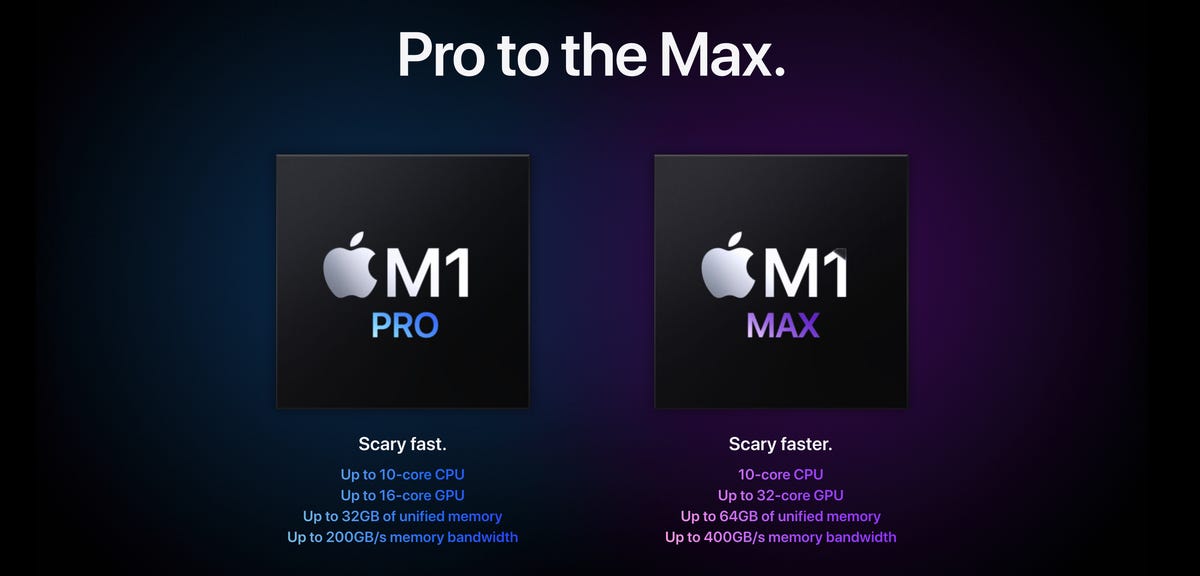The new 14-inch Apple MacBook Pro (14.2 inches to be precise) was announced as part of Apple’s Unleashed event on Monday alongside the new 16-inch MacBook Pro. It’s a complete redesign of the 13.3-inch MacBook Pro and is approximately the same size as that model but with a larger display. The laptop is also one of the first to use Apple’s M1 Pro and M1 Max chips that promise faster performance than leading PC processors while using less power.
With the new M1 Pro and Max chips, Apple is promising CPU and GPU performance well above its past Intel systems and more powerful than current Windows laptops at this size. During the event, Apple said the 14-inch Pro is nearly four times faster in CPU performance than the Intel Core i7 13-inch MacBook Pro and up to nine times faster in GPU performance. (Although, nine times faster than that model’s integrated graphics is maybe not saying much.)


Now playing:
Watch this:
The biggest announcements from Apple’s October 2021 event
10:47
The 14-inch base model starts at $1,999 (£1,899, AU$2,999) with the M1 Pro, 16GB of memory and a 512GB SSD. The system memory can be bumped up to 32GB (M1 Pro or M1 Max) or 64GB (M1 Max). And since it uses a unified memory structure, it’s available for both CPU- or GPU-intensive tasks. Despite the performance gains, though, Apple says the 14-inch MacBook Pro’s battery will last for up to 17 hours of video playback.
Also read: M1 Max vs. M1 Pro vs. M1: Apple’s MacBook Pro chips compared


Apple/Screenshot by Josh Goldman/CNET
A faster display to match
The 14-inch MacBook Pro uses a mini-LED display similar to the one Apple used for the current 12.9-inch iPad Pro and its $5,000, 6K-resolution Pro Display XDR monitor. Using LEDs that are 100 times smaller than a standard LED, mini-LED displays have more local dimming zones, giving them greater control over lighting, which loosely translates to high contrast and brightness. The new MacBook Pro also has a P3 wide color gamut. CNET’s Scott Stein said in his review of the 2021 iPad Pro that its mini-LED display feels like an OLED display and, as on Apple’s iPhone Pro models, the colors, dynamic range and contrast feel a lot sharper and black levels are pretty close to perfect.
Read more: Apple’s MacBook Pros: Starting price and how to buy the two new laptops today
Prized for their high contrast and brilliant color, the use of OLED displays in Windows laptops is steadily on the rise. However, they typically have shorter battery life and they don’t have the possible faster refresh rates of LCD displays. The 14-inch MacBook Pro’s mini-LED, on the other hand, will have an adaptive refresh rate up to 120Hz, which Apple calls ProMotion.
The display is also topped with a new 1080p webcam. The usable display space wraps the camera, putting a notch at the top of your screen just like the iPhone’s. The webcam is joined by improved mics and speakers that promise to help you with content creation and boost your FaceTime quality.
Read more: Whoa, a MacBook Pro with all the upgrades will cost you how much?


Now playing:
Watch this:
New MacBook Pro: MagSafe returns
4:44
MagSafe, ports and no Touch Bar
While it was pretty safe to expect better displays and faster performance for the new MacBook Pros, we were surprised to see Apple roll back some of its past Pro design features. The new 14-inch MacBook Pro has three Thunderbolt 4/USB 4 Type-C ports joined by an HDMI-out, a 3.5mm headphone jack and an SDXC memory card slot.
Apple also brought back its magnetic charging adapter with MagSafe 3. The connector allows you to quickly plug in the laptop for charging and if you trip over the cord it pops off without dragging your MacBook to the floor. The new models are also the first MacBook Pros to support fast-charging.
However, one thing that didn’t make a return is the Touch Bar, which has been replaced by a standard set of Apple function keys. I’m sure the Touch Bar has its fans, but it didn’t seem to catch on the way Apple had hoped.
See also
- Apple event recap: AirPods 3, new MacBook Pro and more
- Apple unveils new AirPods at $179
- Apple’s MacBook Pro display features a new notch, faster refresh rate




